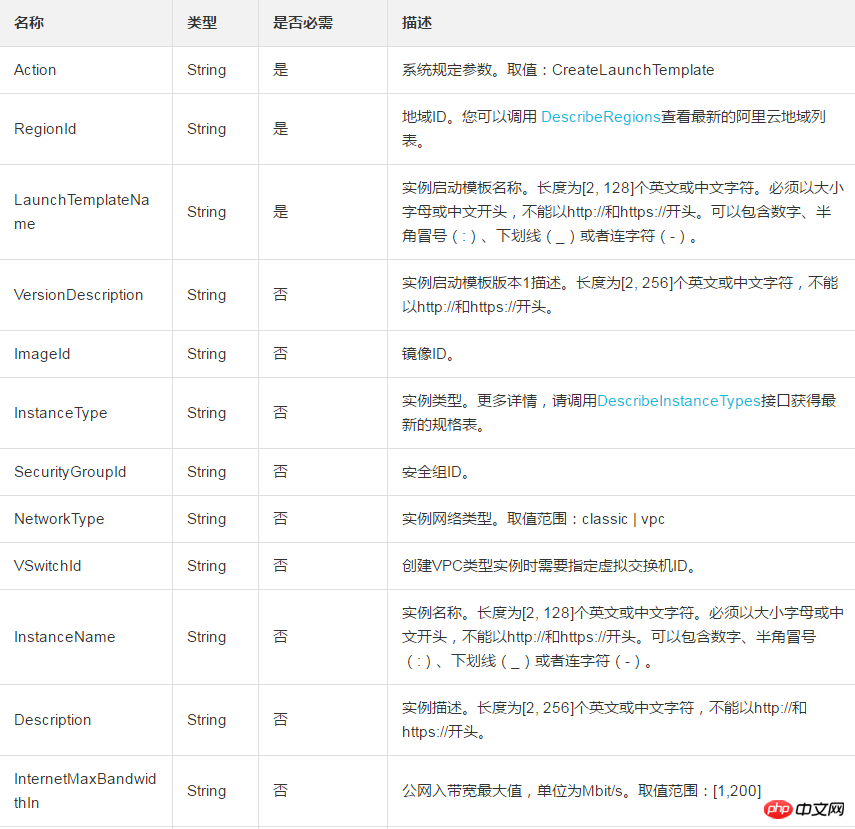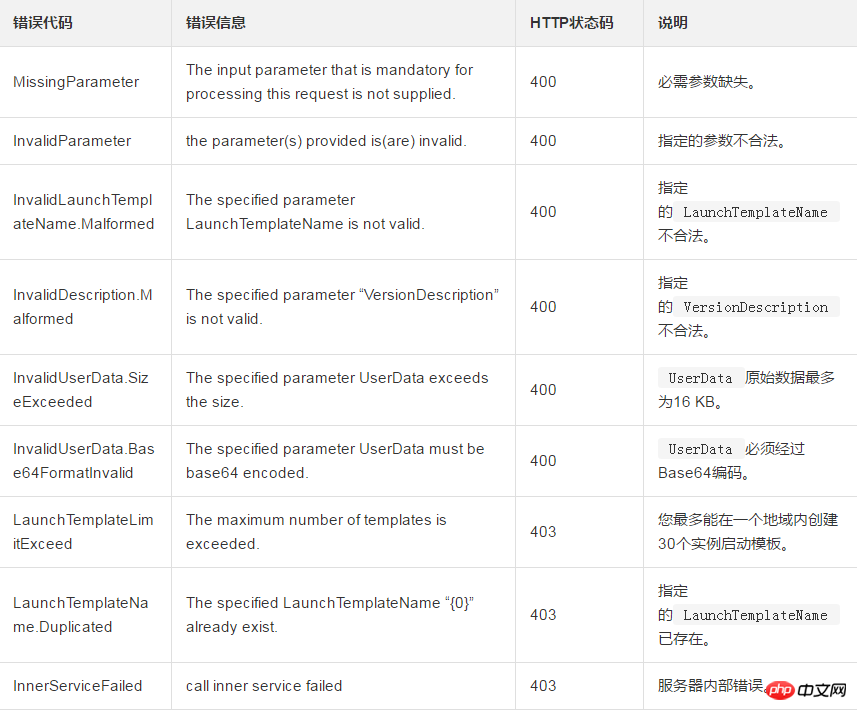 Operation and Maintenance
Operation and Maintenance
 Linux Operation and Maintenance
Linux Operation and Maintenance
 How to eliminate the need to fill in a large number of configuration parameters every time you create an instance - Create an instance startup template
How to eliminate the need to fill in a large number of configuration parameters every time you create an instance - Create an instance startup template
How to eliminate the need to fill in a large number of configuration parameters every time you create an instance - Create an instance startup template
The content of this article is about how to avoid the need to fill in a large number of configuration parameters every time you create an instance. It has certain reference value. Friends in need can refer to it. I hope it will be helpful to you. help.
CreateLaunchTemplate
Create an instance launch template, referred to as a template. Instance launch templates eliminate the need to fill in a large number of configuration parameters every time you create an instance.
Description
The instance startup template contains related configurations for creating instances, such as the region to which the instance belongs, image ID, instance specifications, and security Group ID and public network bandwidth, etc. If an instance configuration is not specified in the template, you need to specify the configuration for the instance when you create it. After creating a template (CreateLaunchTemplate), the initial version of the template is 1. You can subsequently create multiple template versions (CreateLaunchTemplateVersion) based on this version. The version numbers increase sequentially starting from 1. If you do not specify a template version number when creating an instance (RunInstances), the default version will be used.
When calling this interface, you need to note:
You can create up to 30 instance startup templates in a region, and each template can have up to 30 versions.
Most of the parameters of the instance startup template are optional parameters. When creating a template, we will not verify the existence and validity of parameter values in the template. The validity of parameter values will only be verified when the instance is actually created.
If a certain configuration is set in the instance startup template, the configuration cannot be filtered out when creating the instance (RunInstances). For example, if the template sets HostName=LocalHost and the value of HostName in RunInstances is empty, the host name of the instance is still LocalHost. If you want to override the configuration HostName=LocalHost, you can set HostName=MyHost or other parameter values in RunInstances.
Request parameters

##Return parameters

Example
Request Example
https://ecs.aliyuncs.com/?Action=CreateLaunchTemplate &RegionId=cn-hangzhou &LaunchTemplateName=lt-name1 &InstanceType=ecs.cm4.6xlarge &SecurityGroupId=sg-securitygroupid &<公共请求参数>
Return example
XML format
<CreateLaunchTemplateResponse>
<RequestId>04F0F334-1335-436C-A1D7-6C044FExxxxx</RequestId>
<LaunchTemplateId>lt-m5eiaupmvm2op9dxxxxx</LaunchTemplateId>
</CreateLaunchTemplateResponse>JSON format
{
"RequestId": "04F0F334-1335-436C-A1D7-6C044FExxxxx",
"LaunchTemplateId": "lt-m5eiaupmvm2op9dxxxxx"
}Error code
The following are error codes unique to this interface. For more error codes, please visit the API Error Center.
The above is the detailed content of How to eliminate the need to fill in a large number of configuration parameters every time you create an instance - Create an instance startup template. For more information, please follow other related articles on the PHP Chinese website!

Hot AI Tools

Undresser.AI Undress
AI-powered app for creating realistic nude photos

AI Clothes Remover
Online AI tool for removing clothes from photos.

Undress AI Tool
Undress images for free

Clothoff.io
AI clothes remover

AI Hentai Generator
Generate AI Hentai for free.

Hot Article

Hot Tools

Notepad++7.3.1
Easy-to-use and free code editor

SublimeText3 Chinese version
Chinese version, very easy to use

Zend Studio 13.0.1
Powerful PHP integrated development environment

Dreamweaver CS6
Visual web development tools

SublimeText3 Mac version
God-level code editing software (SublimeText3)

Hot Topics
 deepseek web version entrance deepseek official website entrance
Feb 19, 2025 pm 04:54 PM
deepseek web version entrance deepseek official website entrance
Feb 19, 2025 pm 04:54 PM
DeepSeek is a powerful intelligent search and analysis tool that provides two access methods: web version and official website. The web version is convenient and efficient, and can be used without installation; the official website provides comprehensive product information, download resources and support services. Whether individuals or corporate users, they can easily obtain and analyze massive data through DeepSeek to improve work efficiency, assist decision-making and promote innovation.
 How to install deepseek
Feb 19, 2025 pm 05:48 PM
How to install deepseek
Feb 19, 2025 pm 05:48 PM
There are many ways to install DeepSeek, including: compile from source (for experienced developers) using precompiled packages (for Windows users) using Docker containers (for most convenient, no need to worry about compatibility) No matter which method you choose, Please read the official documents carefully and prepare them fully to avoid unnecessary trouble.
 Ouyi okx installation package is directly included
Feb 21, 2025 pm 08:00 PM
Ouyi okx installation package is directly included
Feb 21, 2025 pm 08:00 PM
Ouyi OKX, the world's leading digital asset exchange, has now launched an official installation package to provide a safe and convenient trading experience. The OKX installation package of Ouyi does not need to be accessed through a browser. It can directly install independent applications on the device, creating a stable and efficient trading platform for users. The installation process is simple and easy to understand. Users only need to download the latest version of the installation package and follow the prompts to complete the installation step by step.
 BITGet official website installation (2025 beginner's guide)
Feb 21, 2025 pm 08:42 PM
BITGet official website installation (2025 beginner's guide)
Feb 21, 2025 pm 08:42 PM
BITGet is a cryptocurrency exchange that provides a variety of trading services including spot trading, contract trading and derivatives. Founded in 2018, the exchange is headquartered in Singapore and is committed to providing users with a safe and reliable trading platform. BITGet offers a variety of trading pairs, including BTC/USDT, ETH/USDT and XRP/USDT. Additionally, the exchange has a reputation for security and liquidity and offers a variety of features such as premium order types, leveraged trading and 24/7 customer support.
 Get the gate.io installation package for free
Feb 21, 2025 pm 08:21 PM
Get the gate.io installation package for free
Feb 21, 2025 pm 08:21 PM
Gate.io is a popular cryptocurrency exchange that users can use by downloading its installation package and installing it on their devices. The steps to obtain the installation package are as follows: Visit the official website of Gate.io, click "Download", select the corresponding operating system (Windows, Mac or Linux), and download the installation package to your computer. It is recommended to temporarily disable antivirus software or firewall during installation to ensure smooth installation. After completion, the user needs to create a Gate.io account to start using it.
 Ouyi Exchange Download Official Portal
Feb 21, 2025 pm 07:51 PM
Ouyi Exchange Download Official Portal
Feb 21, 2025 pm 07:51 PM
Ouyi, also known as OKX, is a world-leading cryptocurrency trading platform. The article provides a download portal for Ouyi's official installation package, which facilitates users to install Ouyi client on different devices. This installation package supports Windows, Mac, Android and iOS systems. Users can choose the corresponding version to download according to their device type. After the installation is completed, users can register or log in to the Ouyi account, start trading cryptocurrencies and enjoy other services provided by the platform.
 gate.io official website registration installation package link
Feb 21, 2025 pm 08:15 PM
gate.io official website registration installation package link
Feb 21, 2025 pm 08:15 PM
Gate.io is a highly acclaimed cryptocurrency trading platform known for its extensive token selection, low transaction fees and a user-friendly interface. With its advanced security features and excellent customer service, Gate.io provides traders with a reliable and convenient cryptocurrency trading environment. If you want to join Gate.io, please click the link provided to download the official registration installation package to start your cryptocurrency trading journey.
 Why does an error occur when installing an extension using PECL in a Docker environment? How to solve it?
Apr 01, 2025 pm 03:06 PM
Why does an error occur when installing an extension using PECL in a Docker environment? How to solve it?
Apr 01, 2025 pm 03:06 PM
Causes and solutions for errors when using PECL to install extensions in Docker environment When using Docker environment, we often encounter some headaches...





